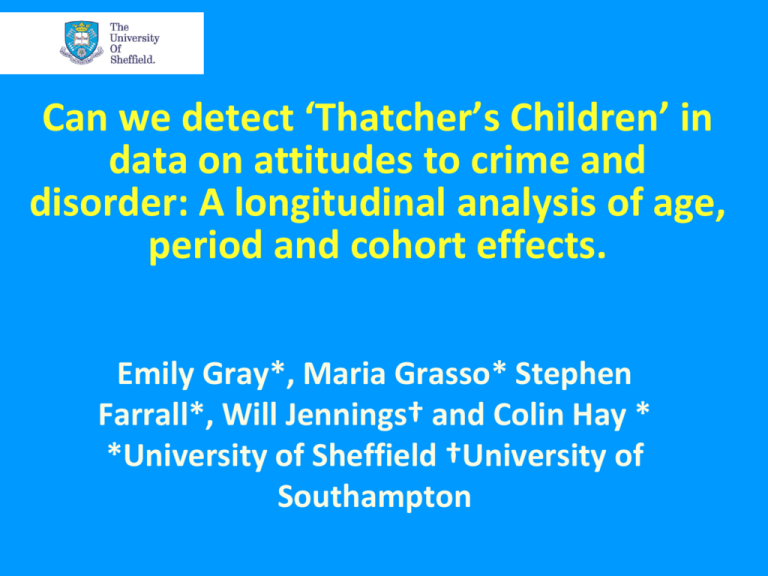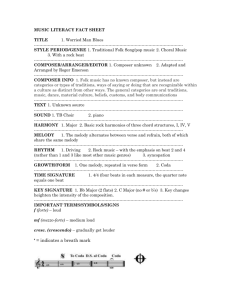The University PowerPoint Template
advertisement

Can we detect ‘Thatcher’s Children’ in data on attitudes to crime and disorder: A longitudinal analysis of age, period and cohort effects. Emily Gray*, Maria Grasso* Stephen Farrall*, Will Jennings† and Colin Hay * *University of Sheffield †University of Southampton Introduction Crime became a key issue in UK political and social agendas in three ways: 1: long-term social and economic trends led to increases in crime rates from the 1960s. 2: the economic and social policies (neo-liberalism) pursued from the 1970s/80s accentuated these trajectories, adding to rises in crime. 3: competition between political parties on the issue of crime raised the profile of crime as an issue and added to levels of public concern over crime. 4: feed-back loops between these operated to foster those circumstances which produced crime and in turn led to the rise of crime as an object of political concern (neoconservatism). Theoretical and substantive contexts • Other authors have sought highlighted the links between crime and political/ cultural shifts (Garland, 2001, Young, 1999). However: • Both cite ‘post modernity’, ‘late modernity’ as driving factors – no political dimension. • Ignore specific Government policies. • Focus on experiences of the middle class. Age, Period, Cohort Analysis • Longitudinal analysis of BCS/ CSEW data (1982-2012) affords an APC analysis (Ryder, 1965). • Exploration of the unique contributions of three types of time-related variations - ‘age, period, and cohort’ effects. • Age effects - changes in the life course; period effects arise via specific cultural and economic changes; cohort effects are the core of social change and represent the effects of formative experiences (Ryder 1965). • Ipsos Mori :‘Generation Y’ / ‘millennials’ Table 1. Political Generations in British Crime Survey Data Cohorts (1) PreWelfare State Generation (2) Post-War (3) Wilson/ Consensus Callaghan Generation Generation (4) Thatcher (5) New and Major’s Labour’s Children Children Era/period 1930-1944 1945-1964 1965-1978 1979-1996 1997-2010 Years of birth 1910-1924 1925-1944 1945-1958 1959-1976 1977-1990 N (Tot. 620,900) 40,528 160,533 147,087 195,026 77,726 Thatcher’s children? BCS/ CSEW data 1982-2012 Table 2. BCS indicators for analysis Questionnaire item Original response categories Recode for analysis Could you tell me how worried you are about...? Having your home broken into and being burgled 1 2 3 4 Very worried Fairly worried Not very worried Not at all worried 1/2= 1 worried about being mugged 3/4= 0 not worried Could you tell me how worried you are about...? Being mugged and robbed 1 2 3 4 Very worried Fairly worried Not very worried Not at all worried 1/2= 1 worried about being mugged 3/4= 0 not worried How common a problem (in this area) are...? Groups of teenagers making a nuisance . 1 Very big problem 2 Fairly big problem 3 Not very big problem 4 Not a problem How common a problem (in this area) are...? Noisy Neighbours. 1 Very big problem 2 Fairly big problem 3 Not very big problem 4 Not a problem 1/2= 1 teenagers a problem 3/4= 0 not a problem Multivaraite models for analysis • Sex • Ethnicity • N Victimisation (in prior 12 months) • Marrital status • Employment status • Education history • Income • Tenure Table 3. Results from multivariate identified APC models Fear of Mugging Fear of Burglary Problem – Neighbours Problem Teenagers 1.332*** 1.504*** 1.541*** 1.561*** 1.441*** 1.750*** 1.997*** 2.054*** 1.303*** 1.777*** 2.220*** 2.324*** 1.364*** 1.609*** 2.517*** 2.620*** 35-59 years of age 0.973* 0.966* 0.954* 0.952*** 60+ years of age 0.959 0.871*** 0.711*** 0.761*** Year of interview 0.965*** 0.952*** 0.996*** 0.979*** N 347,512 348,622 429,631 429,197 Pre-Welfare State (ref. cat.) Post-War Consensus Generation Wilson/ Callaghan Generation Thatcher’s Children Generation New Labour’s Children Generation 16-34 years of age (ref. cat.) Summary of results • Recent victimisation, gender, ethnicity, low education, low income, being in rented accommodation linked to worry about crime and anti-social behaviour. • Pre-welfare state generation least worried about burglary / robbery and anti-social behaviour. • Thatcher’s generation most worried about property crime. • Wilson/ Callaghan’s generation most worried about mugging. • New Labour’s children most concerned about anti-social behaviour Teenagers hanging around – perception of problem by generation Teenagers Hanging Around….? Perceptions of disorder • ASB became a label attached to a huge range of nuisance and petty crime in the 1990s by New Labour (Burney, 2005). • Central part of government’s crime control policy. • Saying teenagers hanging around is ‘a fairly serious problem’ is to report both the existence and significance of symbolic cues of disorder (Sampson & Raudenbush, 2004). • This underlines the contention that the political culture into which one is born, has a lasting effect on an individual’s political values, and their perception of crime and disorder. Summary of results • Strong effect of personal and social variables. • The APC models also provide evidence for ‘pure’ generational effects. • Evidence of clear political socialisation periods, particularly relating to the emotional topic of crime over generations.







